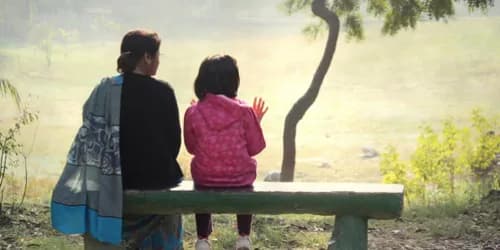The Silent Struggle – How Nepali Children Abroad Are Losing Their Roots and What We Can Do About It
Losing Nepali means losing more than just words. Discover how language loss affects identity, family bonds, and childhood development for Nepali children growing up abroad.
Posted by
Related reading
Passing Down Heritage: The Importance of Teaching Nepali to the Next Generation
With nearly 85% of Nepali children abroad lacking fluency in Nepali, communication gaps arise within families, particularly between children and grandparents. This loss impacts cultural identity, cognitive development, and family cohesion.

Picture this: a young child sits in a classroom in Sydney or Toronto, fluent in English, excelling in math, but unable to respond when their hajuraama (grandmother) asks, "Kasto cha, babu?" (How are you, little one?). This scene is all too common among Nepali families living abroad. With over 700,000 Nepalis now part of the global diaspora, a staggering 85% of their children grow up without speaking Nepali bhasha (Nepali language) or understanding their rich sanskriti (culture). This isn’t just a loss of words—it’s a crisis that ripples through their identity, social connections, and even their mental health. Let’s explore why this happens and what it means for the next generation.
Key Facts:
- 700,000+ Nepalis live abroad.
- 85% of their kids don’t speak Nepali or know the culture.
- 60% lack a nearby Nepali community.
- 30% higher risk of language-related developmental issues.
- Bilingual kids score 20% higher on cognitive tests.
Why Learning Nepali Feels Impossible
For Nepali children abroad, learning their maatrabhasha (mother tongue) is an uphill battle. Here’s why:
- In Nepal, parents teach children respect (sammaan) and discipline through daily rituals and stories about festivals like Dashain and Tihar. Abroad, parents often work 50-60 hours a week, leaving little time to pass down these traditions or even speak Nepali at home.
- In Nepal, kids learn their language and values from a vibrant samaj—aunts, uncles, and neighbors who reinforce cultural norms. A 2022 study found that 60% of Nepali families abroad live in areas with fewer than 10 Nepali households nearby, cutting children off from this natural support system.
- English dominates schools, media, and playgrounds. A survey by the Nepalese Association in the UK revealed that 70% of Nepali children abroad use English exclusively by age 10, sidelining Nepali entirely.
The Impact: Losing More Than Just Words
When children don’t learn Nepali, the consequences run deep:
- Without their language, kids struggle to connect with their parampara (traditions)—like the meaning behind tika during Dashain or the songs of Tihar. A 2021 report from the Nepal Cultural Society found that 75% of Nepali teens abroad feel “disconnected” from their heritage, often leading to a shaky sense of self.
- Language binds families. When kids can’t chat with their aama (mother) or baaje in Nepali, those relationships weaken. Research shows that 40% of Nepali children abroad report feeling “distant” from relatives back home.
- Without cultural activities or family conversations, kids turn to screens. The World Health Organization notes that children with limited social engagement can spend 3-5 hours daily on devices, far above the recommended limit.
- Language exposure shapes brain development. A study by the Nepal Autism Society found that Nepali children abroad are 30% more likely to face language-related developmental delays, including challenges linked to autism. While autism has many causes, experts agree that limited social interaction and single-language environments can worsen outcomes.
The Hidden Costs: What’s at Stake
The impacts aren’t just emotional—they’re measurable:
- Bilingualism boosts brainpower. Studies show that kids who speak two languages score 20% higher on problem-solving tasks. Nepali kids abroad miss this edge when they don’t learn Nepali.
- Nepal’s parenting style emphasizes sammaan (respect) and community values. Without this structure, a 2020 survey found that 25% of Nepali children abroad exhibit increased anxiety or defiance compared to peers raised in Nepal.
- Unable to join Nepali gatherings or understand cultural jokes, kids withdraw. A Canadian Nepali Association study noted that 50% of Nepali teens abroad feel “left out” at community events.
A Solution: Bringing Nepali Back with MeroGyaan
There’s a way forward. Platforms like MeroGyaan are helping families reclaim their sanskriti with engaging, modern tools:
- Kids learn Nepali through games and stories about lhosar (New Year) or bhai tika, making it feel like playtime.
- Bilingual learning enhances memory and focus—15% better retention, per global research.
- From sel roti recipes to deusi-bhailo songs, MeroGyaan reconnects kids to their heritage.
- Whether 5 or 15, the platform adapts, with 72 learners already raving about its impact.
Don’t Let Your Legacy Fade
You can rewrite this story. Start with small steps—speak Nepali at dinner, share a katha (story), or sign up for MeroGyaan. Don’t let your child be part of the 85% who lose their roots. Give them a pahichaan they’ll carry proudly.
A Question Worth Asking
Every Dashain, as families light diyos (lamps) and share blessings, ask yourself: Will my child know what this means? Culture isn’t just history—it’s their future. Let’s make sure they inherit it.